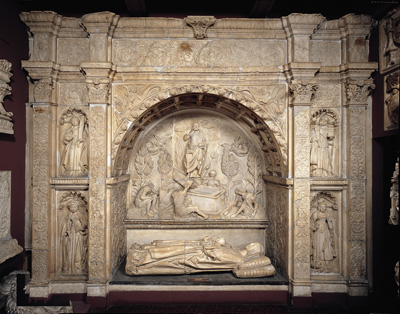Effigy of Mencía Enríquez de Toledo, Relief of Resurrection, and Female Saints
ca. 1500-18
Burgalese and Toledan sculptors
Alabaster
Effigy, l. 195 cm; relief, 178.5 x 224 cm
The tombs from Cuéllar comprise one of the most impressive pans of the Hispanic Society's sculpture collection. The works come from the monastery of San Francisco in Cuéllar (Segovia), where the family of Beltrán de la Cueva, first duke of Alburquerque was buried. The ensemble included a tomb, now lost, of the duke with his first and third wife as well as the two now in the Hispanic Society, those of his brother don Gutierre de la Cueva (d. 1469, bishop of Palencia) and his second wife Mencía Enríquez de Toledo (d. 1479). Because little documentation survives, the history of the project must be reconstructed from the visual evidence and the few facts known. The tombs were apparently undertaken in two campaigns: during the first ca. 1500, sculptors executed bath effigies, almost all of the bishop's tomb, and the reliefs for Mencia Enríquez de Toledo's tomb; the second campaign (ca. 1510-18) saw the completion of the latter tomb with the figures and architectural details. The tombs were then probably installed by 1525.
As an important and wealthy figure under Henry IV and the Catholic Kings, Beltrán de la Cueva commanded considerable resources for this project. Nonetheless, the sculptors remain unknown. Visual comparisons suggest that the artists of the first campaign came from Burgos where they had absorbed the Gothic style of the most important sculptors working there, Gil de Siloe and Felipe Vigarny. The sculptors involved in the second period of activity worked in a Renaissance style associated with Toledo.
Text and images © Hispanic Society of America.
